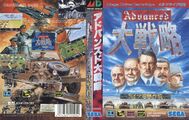Difference between revisions of "Advanced Daisenryaku: Deutsch Dengeki Sakusen"
From Sega Retro
(→Production credits: source) |
|||
| Line 78: | Line 78: | ||
*'''Presented by:''' [[SEGA]] 1991 | *'''Presented by:''' [[SEGA]] 1991 | ||
| source=In-game credits | | source=In-game credits | ||
| + | | pdf=Advanced Daisenryaku MD credits.pdf | ||
| console=MD | | console=MD | ||
}} | }} | ||
Revision as of 18:42, 3 January 2024
| Advanced Daisenryaku: Deutsch Dengeki Sakusen | ||||||||||
|---|---|---|---|---|---|---|---|---|---|---|
| System(s): Sega Mega Drive | ||||||||||
| Publisher: Sega | ||||||||||
| Developer: Sega R&D 9[1] | ||||||||||
| Licensor: SystemSoft | ||||||||||
| Sound driver: SMPS Z80 | ||||||||||
| Peripherals supported: Mega Modem | ||||||||||
| Genre: Simulation[2][3] | ||||||||||
| Number of players: 1-4 | ||||||||||
|
This short article is in need of work. You can help Sega Retro by adding to it.
Advanced Daisenryaku: Deutsch Dengeki Sakusen (アドバンスド大戦略 ドイツ電撃作戦), commonly referred to simply as Advanced Daisenryaku, is a 1991 strategy game developed by Sega for the Sega Mega Drive exclusively in Japan. This game is one of the few retail Mega Drive games to have online play compatibility via the Mega Modem.
The game seems to have been announced in 1990 as Super Daisenryaku II (スーバー大戦略II), being a sequel to Super Daisenryaku.
Contents
Story
You control the Wehrmact (German Military during Nazi Era) as they fight in World War II, and consequently you have control over the outcome of the war.
Gameplay
Battlefields are tiled hexagons arranged on a small landscape. With the cursor over one of your tanks and other military fleet, ![]() opens a menu where you can do various military tasks to the item, such as equipping it with weapons.
opens a menu where you can do various military tasks to the item, such as equipping it with weapons. ![]() opens a menu where you can set up the game in a variety of ways. When you have felt you have done enough in your turn, hit START and choose "End Turn" to end your turn.
opens a menu where you can set up the game in a variety of ways. When you have felt you have done enough in your turn, hit START and choose "End Turn" to end your turn.
Units can be upgraded to newer, more powerful versions if they gain enough experience.
Campaign mode allows players to play most of the battles fought by Germany, from Poland to Fall of Berlin. However, similar to SSI's Panzer General series, players can find themselves in hypotetichal scenarios such as invasion of Britain or United States if they perform very well during the campaign missions.
If game is completed in this way, an ending text mentions the war crimes committed by the Axis during the World War 2.
Even though game's cover has other world leaders during the WW2, other sides are only playable during the scenario mode and not avaiable for the campaign.
History
It was licensed by SystemSoft as part of Daisenryaku series of strategy games, and also started the Advanced Daisenryaku line, all of which have been published by Sega.
Sega ported this game to Playstation 2 in 2006 as part of Sega Ages 2500.
In 2002-2006, Nebelwurfer [1] released a partially completed patch, fan-translating the title to English as Advanced Military Commander along with a translated manual.
Production credits
- Total Planner: Shakkin Oh
- considertion & event scene: Marusan
- system & battle scene: Shoozy
- Modem: Sensou Hantai
- total art directer: Jijy
- unit design:
- air unit: Cotani
- land unit: Judy★Totoya
- ship unit: Jijy
- back ground visual design: Chie Sama
- opening music: T.M
- ending music: Macky
- pax germana: Galapagos
- highland laddie: Macky
- pax russiana: Galapagos
- US artillery march: Jimita
- la marseillaise: Jimita
- pax italiana: Galapagos
- glorious day: Bluetz Lee
- Map Editer: Shakkin Oh, S2, Jiji, J.Toyoda
- Media mix: Shigeru Tanaka, Hiroki Endoh, Takao Sasamura
- Checker: Toshihiki Sasaki, Koji Shimada, Tatsuya Igarashi, Takashi Ogiwara, Takashi Kurihashi, Yasushi Miki, Yuichiro Miura, San
- Model Maker: Cotani, Phenix Rie, Lee, Locky★P, Papa, Chie Sama, Rew, Carol Akitsu, Hatter, Kakuka
- Instruction Manual: Rantz
- special thanks: Sensha Magazine, NOTAM‑D
- Original Game: SystemSoft
- Presented by: SEGA 1991
Magazine articles
Promotional material
also published in:
- Mega Drive Fan (JP) #13: "February 1991" (1991-01-08)[5]
also published in:
- Mega Drive Fan (JP) #14: "March 1991" (1991-02-08)[6]
also published in:
- Mega Drive Fan (JP) #15: "April 1991" (1991-03-08)[7]
Physical scans
| Sega Retro Average | ||||||||||||||||||||||||||||||||||||||||||||
|---|---|---|---|---|---|---|---|---|---|---|---|---|---|---|---|---|---|---|---|---|---|---|---|---|---|---|---|---|---|---|---|---|---|---|---|---|---|---|---|---|---|---|---|---|
|
| 84 | |
|---|---|
| Based on 8 reviews | |
Technical information
References
- ↑ https://www.sega.jp/fb/album/10_add/interview2.html
- ↑ File:ADDDS MD JP Box.jpg
- ↑ 3.0 3.1 https://sega.jp/history/hard/megadrive/software.html (Wayback Machine: 2020-07-20 09:51)
- ↑ File:Advanced Daisenryaku MD credits.pdf
- ↑ Mega Drive Fan, "February 1991" (JP; 1991-01-08), page 3
- ↑ Mega Drive Fan, "March 1991" (JP; 1991-02-08), page 37
- ↑ Mega Drive Fan, "April 1991" (JP; 1991-03-08), page 85
- ↑ Beep! MegaDrive, "June 1991" (JP; 1991-05-08), page 28
- ↑ Console XS, "June/July 1992" (UK; 1992-04-23), page 126
- ↑ Famitsu, "1991-xx-xx" (JP; 1991-06-28), page 19
- ↑ Hippon Super, "July 1991" (JP; 1991-06-04), page 114
- ↑ Mega Drive Fan, "September 1991" (JP; 1991-08-xx), page 115
- ↑ Sega Pro, "November 1991" (UK; 1991-xx-xx), page 18
- ↑ Sega Pro, "April 1993" (UK; 1993-03-11), page 64
- ↑ Sega Saturn Magazine, "September 1995" (JP; 1995-08-08), page 84





